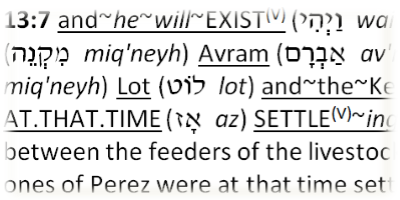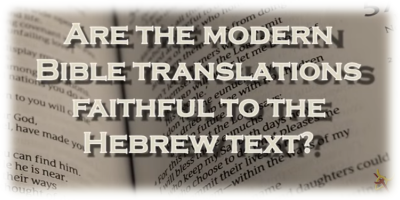Is a Mechanical Translation Possible?
I have been told that a word for word translation is not possible as each word can have several meanings and the context will determine how each word is to be translated. I have found that this is not exactly true and it is possible to translate each word the same each time it occurs. However, the problem is that we need to understand the Hebrew vocabulary from an Hebraic perspective. To demonstrate this philosophy, let me use the English word branch as an example.
What is a branch? I suppose that most of us would think of the branch of a tree such as in the sentence below.
The bird landed on the branch.
Now examine the word branch. in the following sentence.
The bank said there is a branch on 1st Street.
Notice that the same word is used, but the context shows a different application for this word. The word branch can also be used a the branch of a river, a family line or a branch of science.
The literal meaning of the word branch is a division or section.
The Hebrew word for a branch is מטה (mateh, Strong's #4294) and is used in the following passages.
Exodus 4:17 - and you will take this branch [staff] in your hand
Exodus 31:2 - The son of Hur, from the branch [tribe] of Judah
Isaiah 9:3(4) - For you have broken the yoke of his burden, and the branch [yoke] of his shoulder
Now let's look at a Hebrew word where the connections may not be as obvious. Each of the following passages have the Hebrew word איל (ayil, Strong's #352) meaning, someone or something that is strong and large in stature, a "buck."
Exodus 15:15 - the bucks [chiefs] of Moab
Exodus 29:16 - and you will slaughter the buck [a male from the sheep or goats]
Ezekiel 40:16 - and their bucks [posts] within the gate
Isaiah 61:3 - they will be called bucks [trees] of righteousness, a planting of YHWH
As demonstrated, a "Mechanical," word for word, translation is possible, but it will require the reader to learn the vocabulary of that translation from an Hebraic perspective rather than from an English perspective.
What is the Mechanical Translation?
The Mechanical Translation of the Hebrew Bible project began in 2005 with the publication of Mr. Benner's Ancient Hebrew Lexicon of the Bible. This lexicon laid the foundation for a translation of the Hebrew Bible where each word would be translated faithfully according to its original linguistic and cultural perspective. Mr. Benner's vision of this translation included a translation that;
- eliminates personal and religious bias on the part of the translator,
- translates each Hebrew word, prefix and suffix, exactly the same way, every time it occurred in the text,
- could be read and understood by the average person who does not have any prior knowledge of the Hebrew language,
- includes a dictionary of each word used in the translation as well as a concordance, and
- could be used as a tool by those who are learning to read Biblical Hebrew.
To better understand the philosophies and methodologies of this translational project, let's take a closer look at each of the points above.
1. Personal and Religious Bias
It has been argued that it is impossible to eliminate bias into any translation, especially one of a religious nature. However, Mr. Benner has developed a method that almost completely removes the possibility of any personal or religious bias within the translation. This is achieved through a two-fold process.
The first process is through the Lexicon. Each translation and definition of each word in the lexicon is chosen based primarily on its etymology (what is the words meaning based on its relationship to other words and roots), context (how is the word used throughout the Bible) and culture (What did the word mean to those who lived within that culture).
The second part of the process simply involves replacing the Hebrew word, prefix or suffix with its corresponding English word from the Lexicon. This method of translation also has the unique quality that if the reader disagrees with the translation of a Hebrew word, he can simply replace that word with his own and as the translation is accompanied with a concordance, finding the location of each occurrence of that word is fairly simple.
2. A word for word translation
Every translation to date, including interlinears and literal translations, translates the Hebrew text according to context. The problem with this is that the context can be interpreted differently based upon the translators personal opinions of what that context is. In contrast, a word for word, prefix for prefix and suffix for suffix translation is very mechanical and prevents the translator from "fixing" the text.
One advantage to this method of translation is that the reader is able to see the text in its pure and original Hebrew format. However, there is one major drawback to this method of translation. Hebrew syntax (sentence structure and style) is very different from English syntax and a reader that has no background in Hebrew syntax would be completely lost in the translation. To alleviate this problem, the "mechanical" translation is accompanied with a "revised mechanical" translation.
3. Easily read and understood
The "revised mechanical" translation re-arranges the words of the "mechanical" translation into more readable and understandable English syntax. This method of translation is common among other translations but the changes are invisible to the reader. With the "mechanical" and "revised mechanical" translations side by side, the reader is able to see the changes that are made.
There are times when the "revised mechanical" translation is difficult to read and may not make perfect sense, but this is due to the fact that the Hebrew structure of a given sentence is sometimes difficult to read itself. While most other translations "fix" the text so that it will always be read easily, this translation preserves the difficulties. It is the opinion of the author of this translation, that those who will be interested in this translation, will be willing to put in the extra effort to understand a difficult passage.
4. A dictionary and concordance
No one English word can fully convey the meaning of one Hebrew word. For this reason, the translation will include a dictionary that will more finely define each word within its linguistic, contextual and cultural setting. In addition, for in-depth study of the words in the Bible, a concordance will be included that will identify the location of each word within the text.
5. A tool for learning Hebrew
Learning Hebrew is much more than memorizing the meaning of Hebrew words. It involves learning to recognize prefixes and suffixes attached to a word (common Hebrew, much more so than English), verb conjugations (which include subject, tense, gender, number, mood, voice and sometimes the object of the verb) and syntax. When reading the Hebrew text of the Bible, the reader will come across words which will be difficult to decipher. The reader can check the "mechanical" translation to help assist with deciphering the word. The reader is also able to check the "revised mechanical" translation if he is unable to determine the meaning of the sentence itself.
Comparisons between the MT and other translations
Genesis 2:7
| MT: | and~he~will~Mold "YHWH [He exists]" "Elohiym [Powers]" At the~Human Powder From the~Ground and~he~will~Exhale in~Nose~s2~him Breath Life~s and~he~will~Exist the~Human to~Being Life |
| RMT: | and "YHWH [He exists]" of "Elohiym [Powers]" molded the human of powder from the ground and he exhaled in his nostrils a breath of life and the human existed for a being of life, |
| YLT: | And Jehovah God formeth the man -- dust from the ground, and breatheth into his nostrils breath of life, and the man becometh a living creature. |
| KJV: | And the LORD God formed man of the dust of the ground, and breathed into his nostrils the breath of life; and man became a living soul. |
| RSV: | then the LORD God formed man of dust from the ground, and breathed into his nostrils the breath of life; and man became a living being. |
| SET: | And HASHEM God formed the man of dust from the ground, and He blew into his nostrils the soul of life; and man became a living being. |
The name YHWH literally means "he exists" and is derived from the Hebrew verb hawah meaning to "exist." However, the KJV and RSV translate the name YHWH as "the LORD" when the Hebrew word has no connection to the meaning of the word "lord." The SET also replaces the name YHWH with the word HASHEM (a Hebrew word meaning "the name").
The Hebrew YHWH Elohiym is always translated as "LORD God" (KJV, RSV), "Jehovah God" (YLT) or "HASHEM God" (SET) in the standard translations. In Hebrew grammar, two nouns placed together are in the construct state. For instance, in Psalm 24:10 the Hebrew phrase YHWH tseva'ot (the same structure as YHWH Elohiym) is correctly translated in its construct state-"LORD of Hosts." The MT chooses to translate YHWH Elohiym in the same manner-"YHWH of Elohiym."
The KJV and RSV translate the Hebrew nephesh hhayah as "living soul" in this verse while in Genesis 1:24 they translate this very same phrase as "living creature." The SET translates this phrase as "living being" here but as also translates it as "living creature" in Genesis 1:24. Only the YLT remains consistent in how this phrase is translated in these two verses.
Genesis 12:8
| MT: | and~he~will~Advance from~There the~Hill~unto from~East to~"Beyt-El [House of El]" and~he~will~Stretch Tent~her "Beyt-El [House of El]" from~Sea and~the~"Ay [Heap of ruins]" from~East and~he~will~Build There Altar to~"YHWH [He exists]" and~he~will~Call.out in~Title "YHWH [He exists]" |
| RMT: | and he advanced from there unto the hill, from the east to "Beyt-El [House of El]" and he stretched her tent, "Beyt-El [House of El]" was from the sea and "Ay [Heap of ruins]" was from the east and he built there an altar to "YHWH [He exists]" and he called out in the title of "YHWH [He exists]", |
| YLT: | And he removeth from thence towards a mountain at the east of Beth-El, and stretcheth out the tent (Beth-El at the west, and Hai at the east), and he buildeth there an altar to Jehovah, and preacheth in the name of Jehovah. |
| KJV: | And he removed from thence unto a mountain on the east of Bethel, and pitched his tent, having Bethel on the west, and Hai on the east: and there he builded an altar unto the LORD, and called upon the name of the LORD. |
| RSV: | Thence he removed to the mountain on the east of Bethel, and pitched his tent, with Bethel on the west and Ai on the east; and there he built an altar to the LORD and called on the name of the LORD. |
| SET: | From there he relocated to the mountain east of Beth-el and pitched his tent, with Beth-el on the west and Ai on the east; and he built there an altar to HASHEM and invoked HASHEM by name. |
The Hebrew word ahaloh is not grammatically correct. This pronunciation only comes from the Masoretic Hebrew text which has added the nikkudot (vowel pointings) to Hebrew words. The original spelling of this word is a-h-l-h and can only be pronounced as ahalah. Ahalah can be translated in two ways, "unto the tent" (which does not fit with the context of the passage) or "her tent." In the modern day Bedouin tribes of the Near East, which live very much the same as in the days of Abraham, the tent always belongs to the wife. It appears that this custom was also in use in the days of Abraham as the passage literally identifies the tent as "her tent."
The MT footnote to this verse reads; The phrase "he called out in the title" may also be translated as "he met with the title." All Hebrew names are titles in the sense that the name identifies the personality or character of an individual. The "title," or "character" of YHWH, may be his representative (such as "the messenger of YHWH"). There are two meanings behind the word verb qara, one is to "call out" and the other is "to meet" (in the sense of calling someone out to meet with him). Therefore, a possible interpretation of this verse is that Abraham "met with a representative (messenger) of YHWH.
Genesis 20:17, 18
| MT: | and~he~will~self~Plead "Avraham [Father lifted]" To the~"Elohiym [Powers]" and~he~will~Heal "Elohiym [Powers]" At "Aviymelekh [My father is king]" and~At Woman~him and~Bondwoman~s~him and~they(m)~will~Bring.forth Given.that >~Stop he~did~Stop "YHWH [He exists]" Round.about All Bowels to~House "Aviymelekh [My father is king]" Upon Word "Sarah [Noblewoman]" Woman "Avraham [Father lifted]" |
| RMT: | and "Avraham [Father lifted]" pleaded to the "Elohiym [Powers]" and "Elohiym [Powers]" healed "Aviymelekh [My father is king]" and his woman and his bondwomen and they brought forth, given that "YHWH [He exists]" stopped round about all the bowels to the house of "Aviymelekh [My father is king]" because of "Sarah [Noblewoman]" the woman of "Avraham [Father lifted]", |
| YLT: | And Abraham prayeth unto God, and God healeth Abimelech and his wife, and his handmaids, and they bear: for Jehovah restraining had restrained every womb of the house of Abimelech, because of Sarah, Abraham's wife. |
| KJV: | So Abraham prayed unto God: and God healed Abimelech, and his wife, and his maidservants; and they bare children. For the LORD had fast closed up all the wombs of the house of Abimelech, because of Sarah Abraham's wife. |
| RSV: | Then Abraham prayed to God; and God healed Abimelech, and also healed his wife and female slaves so that they bore children. For the LORD had closed all the wombs of the house of Abimelech because of Sarah, Abraham's wife. |
| SET: | Abraham prayed to God, and God healed Abimelech, his wife, and his maids, and they were relieved; for HASHEM had completely restrained every orifice of the household of Abimelech, because of Sarah, the wife of Abraham. |
According to Young's, the KJV and the RSV, the illness YHWH placed on Aviymelekh, his wife and her bondwomen was that their wombs were restrained and they bore (KJV and RSV add the word "children" which is not in the Hebrew text). The first problem with this interpretation is that Aviymelekh, who doesn't have a womb and is not able to bear "children," was also stricken with this illness. The second problem is that according to verse 7, this illness would kill them. While the Hebrew verb yalad is usually used in the context of "bringing forth (bearing) children," the literal meaning of this verb is simply to "bring forth." The Hebrew text literally states that their bowels could not "bring forth, most likely, they were suffering from constipation.

Like what you’re discovering? Continue the journey from Bible reader to translator.
|






